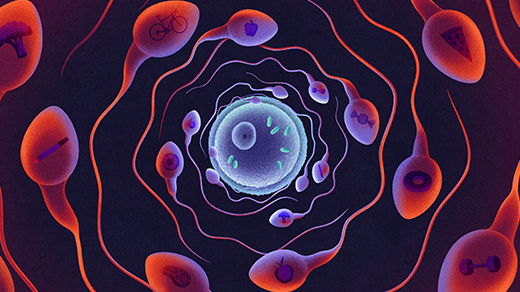Our Genes May Explain Severity of COVID-19 and Other Infections

Infections like COVID-19 may vary widely in severity because some individuals have small weaknesses in their immune defenses that only one pathogen can exploit.
Samantha Mash for Quanta Magazine
Introduction
Why was a marathon runner in his 40s stricken with a case of COVID-19 so severe it landed him in the intensive care unit? Why did a healthy 12-year-old boy lose his life to a disease that mostly harms older people? One of the most terrifying aspects of the pandemic is that the severity of the disease seems so cruelly and arbitrarily variable.
Although the SARS-CoV-2 virus is most often fatal in patients who are elderly or have chronic medical conditions such as diabetes, heart disease or high blood pressure, exceptions that bring down apparently healthy young people are commonplace. Even patients who do not die of the infection show a huge spread in their symptoms: Some never get sick; some need to be hospitalized but recover; some have lingering disabilities that last for months.
So far, scientists have been largely at a loss to explain why COVID-19 hits patients as hard as it does, though reasons surely exist. “It’s not just bad luck,” said Helen Su, an immunologist at the National Institute of Allergy and Infectious Diseases.
One possibility under investigation is that some people harbor genes that put them at greater or lesser risk from COVID-19. The COVID Human Genetic Effort, for example, is enrolling hundreds of patients from around the globe who wound up in intensive care after infection with the SARS-CoV-2 virus. Initially, the project only enrolled patients who were under age 50 and had no underlying health conditions, though it has more recently expanded eligibility.
“My hope is to understand the genetic basis of severe COVID in patients of all ages and regardless of comorbidities,” said Jean-Laurent Casanova, a researcher in pediatric medicine and immunology at the Rockefeller University who co-founded the project with Su and others. “And from that, to understand the mechanism that makes them vulnerable to SARS-CoV-2.”
Some genetic clues may already be coming to light. Last week, a team of researchers in the Netherlands published a preliminary communication online in JAMA about four young male patients from two families who all suffered severe COVID-19 respiratory illnesses. The men, who were between the ages of 21 and 32, had no history of chronic medical problems, but DNA sequencing revealed that each of them had a rare form of a gene on his X chromosome that was linked to a deficient immune response. Much more study will be needed to determine whether similar deficiencies, possibly involving other genes, are common among COVID-19’s worst cases. But in a study appearing in Nature today, researchers at the Yale University School of Medicine who followed the progression of COVID-19 in 113 hospitalized patients for two months found that greater severity of the disease was associated with maladaptive immune responses. (The causes for those immunological misfires was not determined.)
The significance of these discoveries may not be limited to COVID-19. Casanova is a champion for an idea that has been slowly gaining credence among medical researchers for many years: that genetics is always a factor in infectious diseases. Many if not all people may have very specific genetic vulnerabilities, such as weaknesses in their immune system, that go unnoticed until one particular pathogen crosses their path. That genetic trait is their Achilles’ heel, and that pathogen is the one thing that can take advantage of it.
The theory has emerged out of both clinical practice and scientists’ growing appreciation of the interconnection between genes and infectious diseases. Casanova has spent the past 25 years scanning the genomes of young people who were inexplicably debilitated by commonplace pathogens like the herpes simplex and varicella zoster viruses (which cause cold sores and chickenpox, respectively). In these children, who showed no outward symptoms of compromised immunity, he has found defects in genes that make them susceptible to severe infection with a single pathogen. In most cases, there were no clinical signs of a genetic problem until they were infected.
“For many of these immune deficiencies where children or adults have very severe infections there is a genetic basis,” said Trine Mogensen, a physician at Aarhus University and a member of the COVID Human Genetic Effort steering committee.
If the COVID project succeeds in finding genes relevant to the course of the infection, it could fuel interest in widening that search for other conditions. Further work on the interplay of infections, immunity and genomes could change how future gene-based medicine routinely diagnoses and treats diseases.
Inborn Errors of Immunity
Infectious disease has always been one of greatest threats to humanity. Before the invention of antibiotics, infections killed half of all children by age 15. Yet as terrible as their collective toll has been, even the worst infectious diseases kill relatively few of those they infect. Tuberculosis has been a scourge, but fewer than 10% of people infected with it even get sick. Even the terrible Spanish flu pandemic that started in 1918 had a mortality rate often estimated at around 2.5%.
Variability in disease severity is usually chalked up to circumstantial factors: the virulence of different pathogen strains, the amount of pathogen exposure, the nutrition or general health of a patient. Researchers have suspected, however, that something more is lurking in the genes of the hardest-hit patients.
The idea of a genetic component to infection dates back to 1905, when an English scientist named Rowland Biffen discovered a gene responsible for a devastating fungal disease called yellow rust that was killing wheat and diminishing crop yields across England. He found that resistance to the fungus was present in some of the plants as a recessive trait passed down from parent to offspring without affecting other characteristics of the plant. The discovery was celebrated, and his method of breeding for resistant plants is still widely used today.
These types of genes were later found in other plants and animals. But genetic immunodeficiencies in humans didn’t start to attract attention until the 1950s, when an immune disorder was identified in an 8-year-old boy being treated at Walter Reed Army Medical Center for recurrent blood infections. The disorder, known as X-linked agammaglobulinemia, inhibits the body’s ability to make the antibodies called gamma globulins, resulting in severe infections even from fairly innocuous pathogens.
The boy had suffered 19 bouts of pneumococcal meningitis, which were repeatedly treated with antibiotics. His condition improved more lastingly only after his physician, Ogden Bruton, discovered that the boy had almost no gamma globulins in his blood. Bruton promptly began treating him with monthly injections of gamma globulins, and the boy survived to adulthood. The discovery, which was described in Pediatrics in 1952, was later recognized as a milestone, highlighting the role of defects of the immune system in inhibiting the fight against infection. These defects were later termed “inborn errors of immunity.”

David Vetter, often remembered as the “bubble boy,” spent his life in a plastic bubble and protective suits because he was born with SCID, a genetic defect that impaired his immune system.
NASA/JSC
Since then, more than 400 inborn errors of the immune system have been documented. Many of them cause susceptibility to all pathogens. The best known may be severe combined immunodeficiency (SCID), nicknamed the “bubble boy” disease after a widely publicized case in the 1970s.
But some immunodeficiencies stemming from a single gene mutation can cause susceptibility to a single pathogen. Such an immunodeficiency is barely detectable unless the person comes into contact with the fateful microbe. Mutations have been found that cause severe disease from herpes simplex virus, human papillomavirus, influenza and mycobacteria (a weakly virulent environmental pathogen related to tuberculosis).
Casanova thinks these discoveries have led to a “shift of paradigm” in the field. He says that “all of a sudden, we’re telling people that in fact the root cause [of infectious disease] is not the environment. It’s not the microbe. It’s the genetic lesion.”
Hidden Immunodeficiencies
These targeted immunodeficiencies became better known through Casanova’s efforts, which began three decades ago when he was a medical resident in Paris. He had been charged with figuring out why some children, who were otherwise perfectly healthy, fell severely ill after receiving the tuberculosis vaccine. The vaccine, known as BCG or bacillus Calmette-Guérin, is composed of a weakened strain of Mycobacterium bovis, a bacterium that infects cattle and is closely related to Mycobacterium tuberculosis. In most people the vaccine has few or no side effects, but in a small group of children it causes severe infection and death.
Casanova gathered data on children in France who were inoculated between 1974 and 1994. During this time, 30 of the children suffered a life-threatening infection after receiving their vaccine. Thirteen of those children had SCID and two had AIDS. In a letter to The Lancet in 1995, Casanova and his co-authors argued that although the other 15 children had no known immunodeficiencies, there was “little doubt” that they were “immunodeficient, and there is good evidence that their immunodeficient status is inherited.”
In the 25 years since then, 17 mutations involving nine genes that influence susceptibility to mycobacterial infection have been uncovered. All the mutations affect a genetic pathway that produces an immune signaling protein called interferon gamma. The absence of this immune signaling protein causes a severe susceptibility to all forms of mycobacteria, not only the highly virulent strains that cause tuberculosis but even weakened strains like the one in the BCG vaccine.
These genetic discoveries are “a huge success story,” according to Vanessa Sancho-Shimizu, an assistant professor of virology and pediatric infectious disease at Imperial College London. “I think almost every case has led to really unprecedented insights to the biology of the disease,” she said. They also led to new clinical treatments. Now, a child who shows up at a hospital with severe mycobacterial infection is tested for these genetic defects and receives injections of interferon gamma.
A Fusion of Genetics and Immunology
The success in treating genetic disorders in mycobacterial disease offers hope that a similar success story is possible for people infirmed by COVID-19. But much work lies ahead. In 2013, Casanova and his colleague Laurent Abel of the Pasteur Institute in Paris published “The Genetic Theory of Infectious Diseases” in the Annual Review of Genomics and Human Genetics to encourage other researchers to more closely examine the influence of mutations and heredity on the patterns of disease they studied. They have updated the proposal in a new paper, accepted for publication at the same journal, that calls for a synthesis of the germ and genetic theories of disease. “Microbe-centered approaches may not sustainably ensure that human life expectancy remains at current levels,” they write in its introduction. “It would be prudent to consider the arms race between humans and microorganisms as a long-term affair, and not to take our apparent success for granted.”
Sancho-Shimizu cautions that Casanova and Abel’s ideas are still catching on: Many medical researchers still “wouldn’t think infection to be something that’s genetically controlled,” she said. But because of genome-wide association studies, scientists are constantly being made aware of the connections between mutations with very specific effects on particular cell types and predispositions to particular infections. “There are a lot of subtleties that we’re able to tease out now, which is fantastic,” she said. “So it’s bringing a lot of knowledge but also a lot of clarity in terms of why certain patients are more susceptible to disease.”



